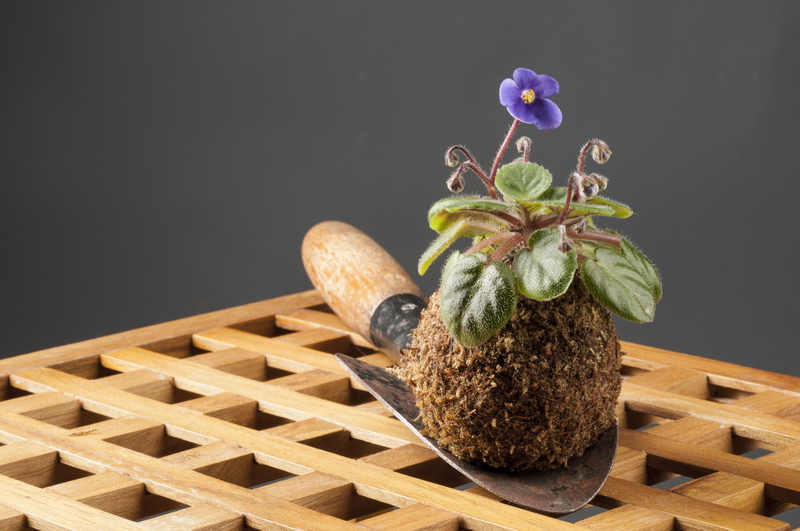Breathe Peace: Design Your Perfect Zen Garden Sanctuary
Posted on 19/09/2025
Breathe Peace: Design Your Perfect Zen Garden Sanctuary
In today's fast-paced world, where noise and chaos seem ever-present, finding harmony and inner peace at home has never been more essential. Creating your own Zen garden sanctuary is an ideal way to foster tranquility, mindfulness, and a place to, quite simply, breathe peace. Let's explore everything you need to know to design your perfect Zen garden--a personal retreat that refreshes both body and spirit.

Why Create a Zen Garden Sanctuary?
- Relieves Stress: Cultivating a Zen garden offers a meditative escape from daily pressures.
- Promotes Mindfulness: The simplicity and balance inherent in Zen garden design foster present-moment awareness.
- Enhances Aesthetic Appeal: Japanese gardens seamlessly blend beauty with function, enhancing any space.
- Encourages a Connection to Nature: Your Zen sanctuary links you harmoniously to the natural world.
- Easy to Maintain: Unlike traditional gardens, minimalism is embraced, making upkeep simple.
If you long to design your perfect Zen retreat, keep reading. This guide shares expert tips on Zen garden origins, design ideas, essential elements, and how to breathe peace into your outdoor or indoor sanctuary.
Understanding the Zen Garden Philosophy
The heart of a Zen garden--or karesansui--lies in embracing simplicity, balance, and harmony. Rooted in ancient Buddhist traditions, these gardens were designed by monks to serve as places of meditation and spiritual contemplation. Elements such as rocks, gravel, sand, and strategically placed plants symbolize aspects of nature (like islands and water), even when actual water isn't present.
Zen Gardens as Spaces for Meditation
Unlike Western gardens overflowing with flowers and color, a Zen sanctuary's goal is to evoke calm through subtlety and minimalism. The act of raking gravel or arranging stones itself becomes meditative--a moving meditation that clears the mind.
Planning Your Zen Garden Paradise
- Choose Your Space: Zen gardens can flourish outdoors in a backyard, or indoors on a tabletop or in a sunroom.
- Determine Your Goals: Is the garden a calming visual scene, a meditative walking path, or a cozy corner for daily reflection?
- Decide on Size: Even the smallest areas can become powerful sanctuaries! You don't need acres--a balcony or small patio works.
Essential Elements of a Zen Garden Sanctuary
1. Sand or Gravel
The iconic element of a Zen garden design is a sea of raked sand or gravel, standing for water or clouds. Raking patterns create waves and ripples--a soothing, repetitive activity that encourages presence and intention. Use crushed granite, pea gravel, or white sand for authentic effect.
2. Rocks and Stones
Stones are the bones of your Zen sanctuary. Arranged in groups of odd numbers, they symbolize mountains or islands, serving as focal points. Vary the sizes and shapes--use rugged rocks for dramatic mountains, smooth stones for balance.
3. Moss and Minimal Plants
Unlike traditional gardens, Zen gardens limit plants to those suggesting tranquility and endurance--think moss, ferns, bamboo, and evergreens. Moss brings greenery yet needs little care, thriving in shady corners and softening hard edges.
4. Water Feature (Optional)
Water is often symbolized, but you may also wish to add a simple stone basin, bamboo fountain, or small pond for added serenity. The gentle sound of flowing water promotes relaxation, transforming your Zen garden retreat into a living soundscape.
5. Bridges, Stepping Stones, and Pathways
Winding paths made from flat stones or wood invite a slow, considered stroll through your Zen sanctuary. Bridges give a sense of passage and transition, while stepping stones encourage mindfulness with every step. Pathways can also be drawn into the sand for smaller gardens.
6. Simple Ornaments and Focal Points
While restraint is key, a single Buddha statue, pagoda lantern, stone water basin, or sculptural feature can offer a visual anchor point. Place these thoughtfully in the landscape, not in the center, to maintain asymmetrical balance--a core Zen garden principle.
Design Principles: Bringing Harmony to Your Zen Sanctuary
- Asymmetry: Zen gardens rarely use mirrored symmetry. Natural, uneven layouts feel more organic and peaceful.
- Balance: Position elements in a way that feels visually weighted, but not uniform. Contrast rough rocks with smooth sand, or dark stones with light gravel.
- Enclosure: Framing your Zen sanctuary with bamboo, hedges, or low walls helps create privacy and a sense of separation.
- Simplicity: The mantra "less is more" reigns. Avoid overplanting or excessive ornamentation.
- Symbolism: Each element represents a natural quality--the raked sand as water, rocks as islands or animals, moss as forest.
Step-by-Step: Creating Your Zen Garden Paradise
- Clear and Prepare the Space: Remove all weeds, debris, and unnecessary items. Level the ground if outdoors.
- Create Boundaries: Use wooden planks, natural stones, or bamboo fencing to define the Zen garden.
- Lay Landscape Fabric (Optional): This helps prevent weeds in your gravel or sand.
- Spread the Sand or Gravel: Pour your chosen material evenly. Aim for a depth of 2-4 inches, thicker if you plan deep raking.
- Position Rocks and Stones: Begin with the largest rocks, partially burying their base for a natural look. Arrange smaller stones as accents.
- Install Moss and Plants: Place in shady, moist areas or alongside rocks. Remember--the fewer, the better. Use containers for added control and flexibility indoors.
- Rake Patterns: Using a wide-toothed wooden rake, create rippling or swirling motifs in the sand or gravel.
- Add the Finishing Touches: Place lanterns or ornaments, ensuring not to overcrowd your sanctuary.
Modern Variations: Zen Garden Ideas for Any Space
- Tabletop Zen Gardens: Perfect for small apartments or office desks. A shallow tray, fine sand, a few stones, and a miniature rake are all you need.
- Indoor Zen Garden Nooks: Convert a sunroom, windowsill, or even a hallway niche with a sleek sand bed and pebbles for instant peace.
- Mixed-Material Gardens: Incorporate polished river stones, driftwood, or glass for a modern twist while retaining Zen principles.
- Water Zen Garden: Use a tabletop water fountain or install a bamboo "shishi-odoshi" to add soothing sound and movement.
Bringing Mindfulness to Your Daily Life
Your Zen garden sanctuary isn't just a pretty space--it's a tool for daily mindfulness. Engage your senses: listen to the crunch of gravel beneath your feet, feel the roughness of rocks, observe the interplay of light and shadow. Each interaction is an invitation to slow down and reconnect with yourself.
Zen Garden Rituals
- Morning Raking: Start your day by refreshing the raked patterns--set your intention for peace and clarity.
- Meditation Sessions: Sit or walk mindfully through the garden, attuning to breath and sensation.
- Seasonal Adjustments: Welcome changing seasons by rotating stones or introducing new moss varieties.
Caring for Your Zen Garden Retreat
- Weed Regularly: Whether inside or out, keeping sand and gravel neat preserves the garden's minimalist look.
- Refresh Patterns: Rake new lines or waves when the surface feels trampled or after heavy rain.
- Trim Moss and Plants: Prune sparingly to maintain tidy lines.
- Clean Water Features: Prevent algae and keep water fresh to enhance both health and beauty.
Inspiration: Famous Zen Gardens Around the World
- Ryoan-ji Temple, Kyoto: The quintessential Zen rock garden, famed for its seventeen enigmatic stones and minimalist sand layout.
- Daitoku-ji Temple, Kyoto: Home to several unique Zen gardens, each offering distinct lessons in asymmetry and balance.
- Portland Japanese Garden, USA: A remarkable example of Zen garden design in a Western setting.
- Adachi Museum of Art, Japan: Its gardens blend with the surrounding natural landscape, creating an endless horizon of tranquility.

Zen Garden Sanctuary: Frequently Asked Questions
Do Zen gardens require a lot of maintenance?
*No!* Zen gardens are intentionally low-maintenance, especially when compared to other landscape styles. With just periodic raking and minimal plant care, your sanctuary stays pristine.
Can I build a Zen garden if I have no outdoor space?
Absolutely. Tabletop Zen gardens are a popular indoor alternative, bringing the spirit of Zen into your living room or office.
What materials are best for a DIY Zen garden?
Choose gravel, white sand, smooth river stones, moss, bamboo, and natural wood. The more organic, the better--avoid plastics or brightly colored objects.
Breathe Peace: Make Your Zen Garden Sanctuary a Reality
In a world that never stops moving, your own Zen garden sanctuary can be your place to pause, reflect, and breathe peace. By blending natural elements, mindful design, and Japanese aesthetic principles, you create an environment that nurtures your inner calm every day.
- Start small--every journey to tranquility begins with a single stone.
- Let your design unfold naturally, guided by intuition and simplicity.
- Embrace the imperfections; every Zen garden is a reflection of nature's unique beauty.
Whether you're seeking inspiration, a hands-on project, or a daily meditative refuge, designing your perfect Zen garden sanctuary is a rewarding practice. With every rake, every stone, and every mindful moment, you're investing in your personal peace--a sanctuary that's always there when you need it most.
Ready to breathe peace? Begin your Zen garden journey today--and watch tranquility blossom in your life.

